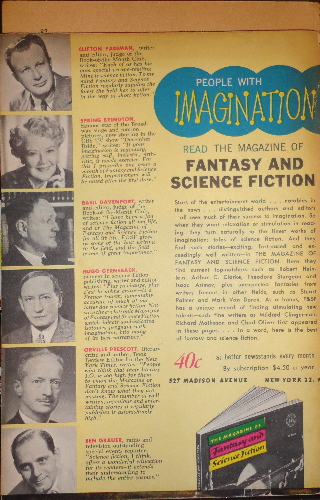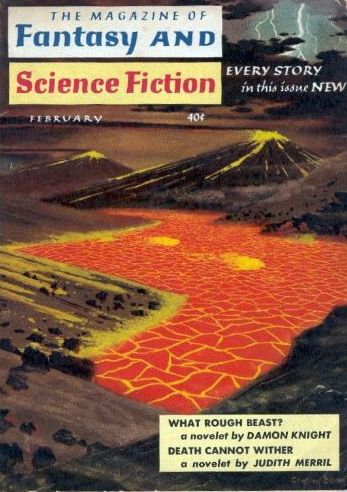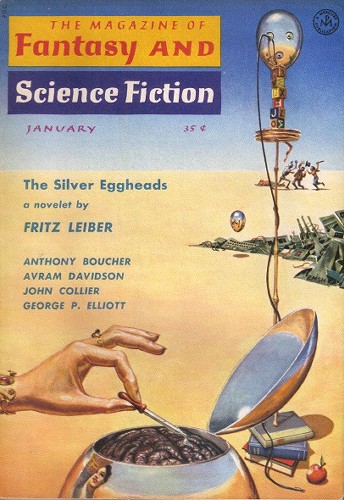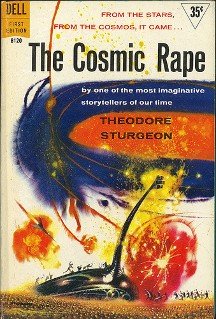
Do you know who reads The Magazine of Fantasy and Science Fiction?
Clifton Fadiman, writer, editor, judge of the Book-of-the-Month Club does. It supplies him his “special escape-reading…the finest the field has to offer in the way of short fiction.”
Spring Byington, famous star of the Broadway Stage does. It improves the imagination, she says.
Basil Davinport, another writer and editor for the Book-of-the-Month Club does. “F&SF gives us some of the best writing in the field, and the field is one of great importance.”
Orville Prescott, Book Review Editor for the New York Times does. He says, “People who think that their literary I.Q. is too high for them to enjoy [F&SF] don't know what they're missing.”
In other words, snobs read F&SF–and you can be a snob, too. Unlike those other lowbrow sci-fi mags, F&SF is the real stuff. Just stay away from Astounding, and for God's sake, avoid Amazing!
I know H.L.Gold was a bit nose-in-the-air when he contrasted Galaxy with Space Westerns, but F&SF is positively the caviar set by comparison. I'm for the promotion of science fiction's respectability, but I don't think F&SF has the sole claim on quality. In fact, I think F&SF's editorial policy leans a bit overmuch toward the superfluously florid.
On the other hand, they are the favored home of more female authors than any other science fiction magazine. And I've never read a Garrett or Silverberg story between its pages, though I did read a horrible Poul Anderson story in F&SF's, thankfully defunct sister magazine, Venture.
Good-natured ribbing aside, while many issues of F&SF may suffer from overwriting-itis, the February 1959 issue is good stuff all the way though (even if the rest of the magazine is not as amazing as its lead story).
Continuing where we left off, Misfit by G.C. Edmondson (the only Mexican science fiction author I know of, and a San Diego native!) is a good yarn about the perils of time travel–to the timeline if not the traveler.
Last month's issue had the first of George Elliot's Venusian stories, Invasion of the Planet of Love. Its sequel, Nothing but Love depicts the Venusian counter-attack. It is less satirical, less impactful, and less interesting. On the other hand, I don't know that I liked the first one very much either. It's not bad, exactly. It's just odd.
I did enjoy Charles Fontenay's Ghost Planet, in which a presumably failed Martian colony is found to have survived through an unexpected and happy circumstance. Apparently, Martian sage grass traps oxygen, so as long as one stays crouched within the grass, there is air and warmth.
Now here's where I need help: I have the strangest feeling that I've seen this gimmick before in another story. Does this sound familiar? I'm hoping one of my many (Webster defines “many” as “more than three”) readers will solve this mystery for me. Drop me a line and let me know. If you don't know the answer, please share this article with someone who might.
Raymond Banks wrote the next story, Natural Frequency, about what happens when someone's voice naturally hits the resonant frequency of… well.. everything. People, glasses, bridges… It's a silly story, reminiscent of that scene from the Bugs Bunny cartoon where Bugs, impersonating the great conductor, Leopold, makes an opera singer sing a high note until his pants fall off and his tuxedo rolls up like a Venetian blind. Filler.
Jane Rice's The Willow Tree is the last piece of the magazine. Per the editorial preface, Ms. Rice wrote for Unknown back in the late '30s, and I have it on good authority that she wrote for a solid ten years after that for various magazines. This story marks the end of a subsequent ten-year hiatus. Tastes vary, but I liked it, this tale of two children sent to the past after losing their parents. It is written like a fairly conventional children's fantasy, much like something Edward Eager would write, but with a much more sinister undertone and ending.
And thusly, we have come to the end. I'd say 4 stars out of 5. The lead story is fantastic, and the rest are decent to quite good.
Normally, one might expect (this being the 27th) that I have the new Astounding and/or F&SF in hand for the next review. However, I am still out in the Territory of Hawai'i, and deliveries are understandably delayed. Forward thinker that I am, I will still have something to discuss on the 29th.
But you'll just have to wait until then to find out what it is.



(Confused? Click here for an explanation as to what's really going on)
This entry was originally posted at Dreamwidth, where it has comments. Please comment here or there.












